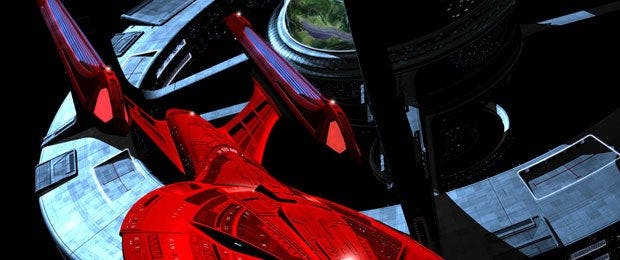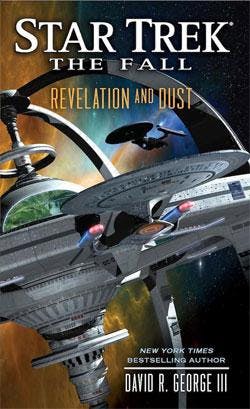Published May 26, 2013
Andy Probert And Douglas E. Graves Talk The Fall
Andy Probert And Douglas E. Graves Talk The Fall

Star Trek: The Fall -- a five-part The Next Generation-Deep Space Nine crossover penned by five popular authors, with covers created by three Star Trek artists -- won’t kick off until, well, the fall. But we here at StarTrek.com are so excited about the upcoming Simon & Schuster project that we’re devoting several days of coverage to it, including interviews and art.

Right below is a synopsis of The Fall: Revelation and Dust provided by Simon & Schuster. And under that, you’ll find an interview with the Andy Probert and Douglas Graves, the artists who collaborated with Doug Drexler on the project.
THE FALL: REVELATION AND DUST SYNPOSISWELCOME TO THE NEW DEEP SPACE 9After the destruction of the original space station by a rogue faction of the Typhon Pact, Miles O’Brien and Nog have led the Starfleet Corps of Engineers in designing and constructing a larger, more advanced starbase in the Bajoran system. Now, as familiar faces such as Benjamin Sisko, Kasidy Yates, Ezri Dax, Odo, and Quark arrive at the new station, Captain Ro Laren will host various heads of state to an impressive dedication ceremony. The dignitaries include not only the leaders of allies—such as Klingon Chancellor Martok, Ferengi Grand Nagus Rom, the Cardassian castellan, and the Bajoran first minister—but also those of rival powers, such as the Romulan praetor and the Gorn imperator. But as Ro’s crew prepares to open DS9 to the entire Bajor Sector and beyond, disaster looms. A faction has already set in action a shocking plan that, if successful, will shake the Alpha and Beta Quadrants to the core. And what of Kira Nerys, lost aboard a runabout when the Bajoran wormhole collapsed? In the two years that have passed during construction of the new Deep Space 9, there have been no indications that the Celestial Temple, the Prophets, or Kira have survived. But since Ben Sisko once learned that the wormhole aliens exist nonlinearly in time, what does that mean with respect to their fate, or that of the wormhole...or of Kira herself?
STARTREK.COM INTERVIEWS WITH ANDY PROBERT AND DOUGLAS E. GRAVESWe’re not sure how closely you follow the Star Trek books. Were you aware that Deep Space Nine had been destroyed in Plagues of Night? Either way, what was your reaction once you heard about its destruction?

forum rp! As a big fan of the show(s), I was bummed to hear the news. However, when I heard that Andrew would be designing a neo Federation-built version of DS9, I was fan-boy-thrilled at the mere thought of it. To be asked by Doug to build her, that was an even bigger thrill.PROBERT: I don't (read the books). No opinion (on DS9’s destruction). I didn't like that station anyway.How pleased were you when Simon & Schuster reached out about creating a NEW Deep Space Nine space station?GRAVES: Literally a dream come true for me. To be able to build/paint a Prime Universe Star Trek model (and a hero model, no less), and a model that was based on an Andrew Probert design to boot, just a cherry on top of an already Trek-based dream come true. A fan-based and career highlight for me.PROBERT: I was very happy to have contributed concepts for its re-design.The idea is that it's the first brand-new 24th century Federation space station that's been built in this era, begging the question: what would that look like? How did you, with Drex, hash out the idea for the new space station's look?GRAVES: Andrew did the lion's share of lifting in regard to the styling of the design, no doubt about it. He drew up his sketches and even created a basic blocked-out Sketch-Up model of his design. With these in hand, I then created the high-resolution finished station configuration. The next phase entailed fleshing out the station detailing, which was based on Andrew's design sketches, combined with my own detailing choices drawn from my own Federation-based design sensibilities, which have become instilled in me over the many decades of watching Star Trek. I shared work-in-progress renders along the way with Doug to garner his always-valued input, and then his final approval of my build and paint-job.PROBERT: The look was pretty much dictated by the authors. I would have designed some elements differently.How long did it take for you all to agree on the look?GRAVES: My work/contributions were established and inspired by Andrew's supplied concepts ideas and Doug's art-direction and final approval.PROBERT: There wasn't a general forum regarding the look. I did the concepts, Deg and Doug did their take on it… boom.How did you then divvy up the process of creating the 3D model and renderings? GRAVES: As mentioned, Andrew did a basic Sketch-Up model concept block-up. Using that as blocking referen

forum regarding the look. I did the concepts, Deg and Doug did their take on it… boom.How did you then divvy up the process of creating the 3D model and renderings? GRAVES: As mentioned, Andrew did a basic Sketch-Up model concept block-up. Using that as blocking reference, I then worked forward to create the final model, following Andrew's sketches and my own design detailing. The final model was then handed off to Doug to create the final scenography rendering/artworkTake us through the final look. What elements most excite you most?GRAVES: I love the whole station, top-to-bottom. At the core, I just love the Federation neo-flow take on such well-known classic lines. Just to see Andrew's sketches was a fan-rush. To see it fully constructed; wow! I love the magnetic rings, the new promenade, the huge environmental recreational dome, all the bays, portholes, landing pads, detailing, all of it. I loved rendering her out and then just looking at her as a fanboy. The design conveys one sleek and busy Federation space station, as it should be.PROBERT: The magnetically-suspended defense rings (top and bottom), the overall size, and the very open-to-space glassed-in promenade.What do you think will surprise/please fans?GRAVES: I feel that fans will be excited at the mere thought of seeing a Federation-designed build of such a classic iconic Star Trek space-station! It's the old Cardassian rust-bucket, made Federation shiny new! I ask you: what's not to like?PROBERT: Probably the closed ring aspect, upgraded from the open towers.Did you work in tandem at all with David R. George and any of the other authors so far as the station's function within The Fall storyline?PROBERT: More with its look than function.Keep an eye on StarTrek.com for more details about The Fall.
